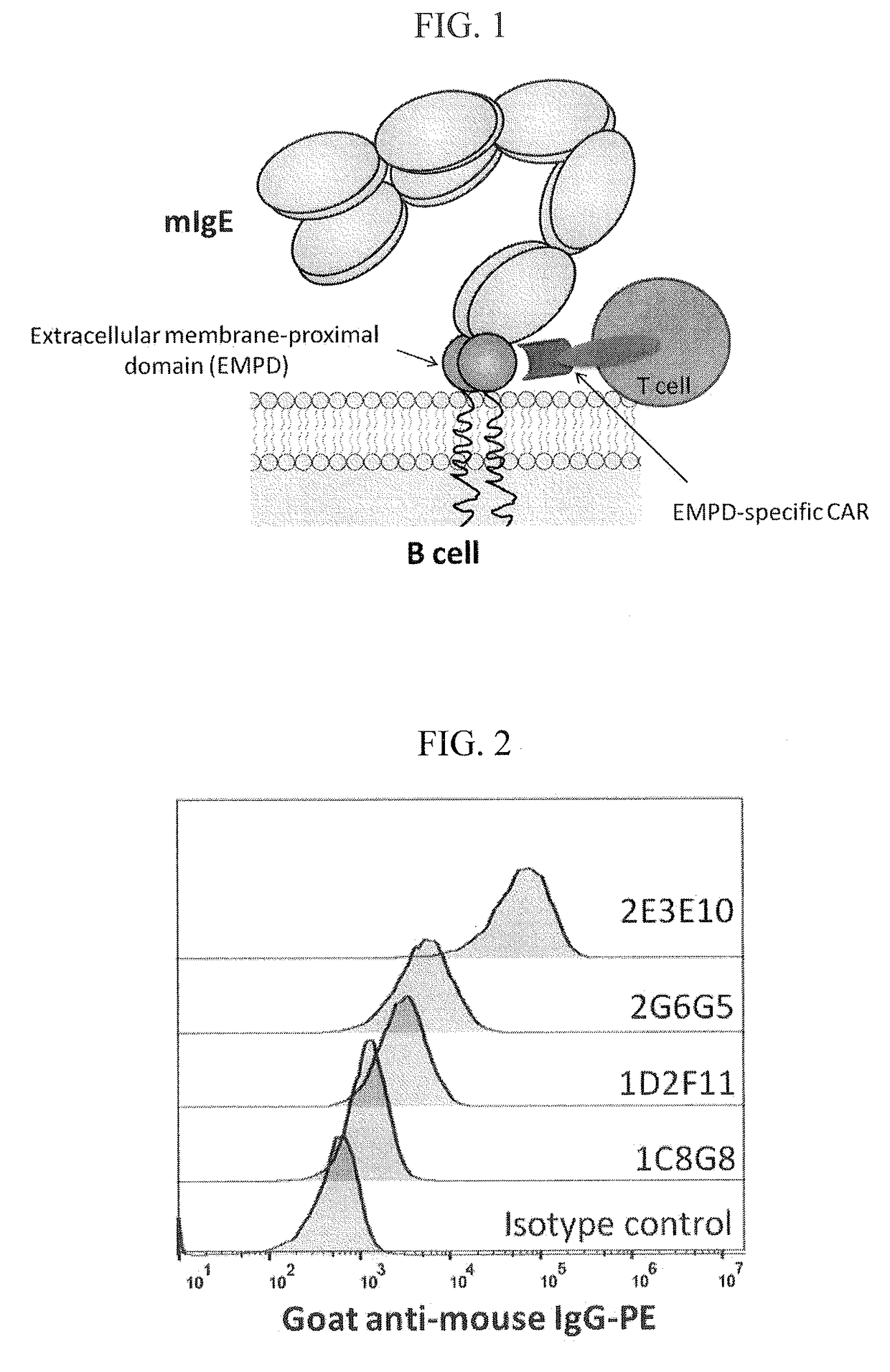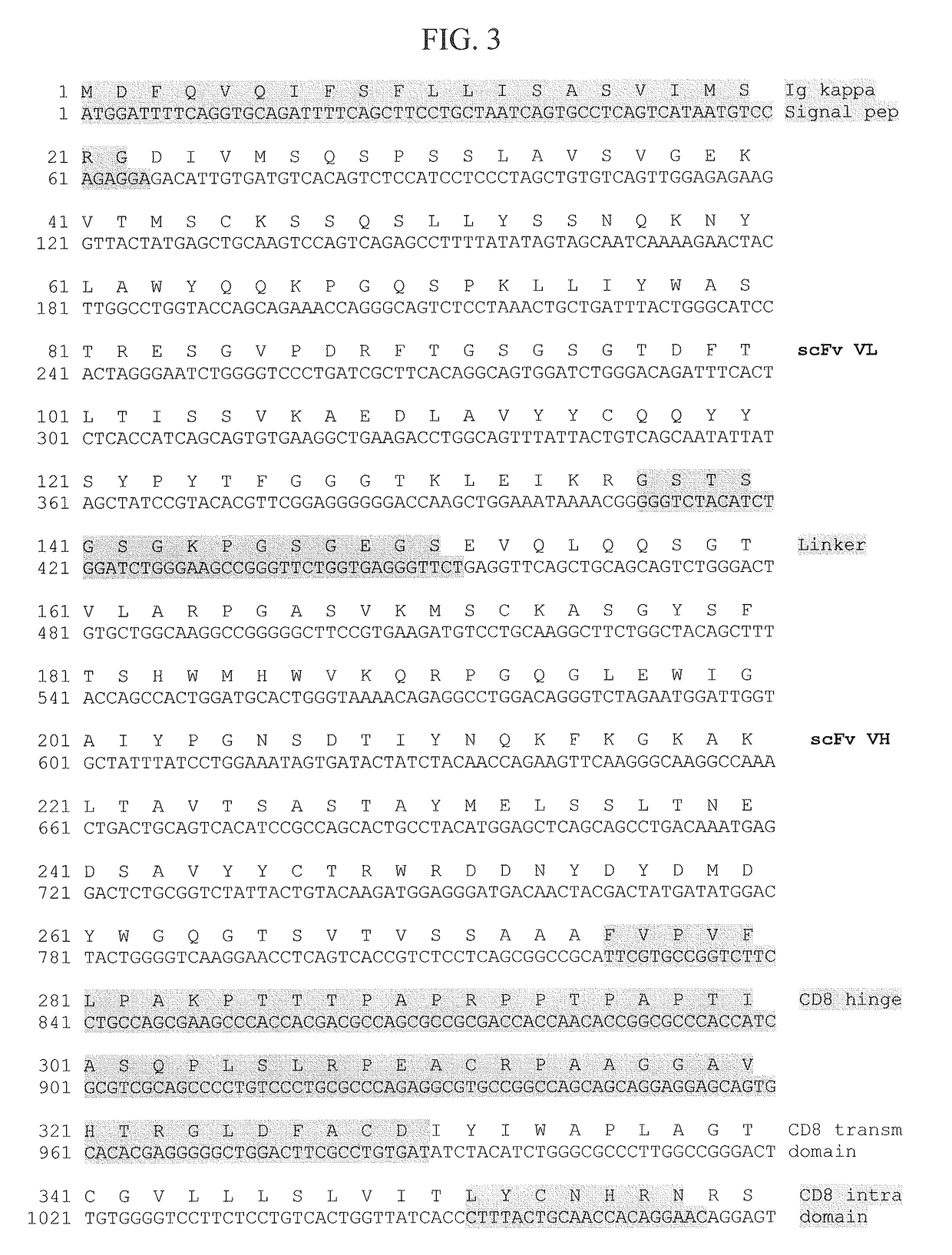ADOPTIVE T-CELL THERAPY USING EMPD-SPECIFIC CHIMERIC ANTIGEN RECEPTORS FOR TREATING IgE-MEDIATED ALLERGIC DISEASES
a t-cell therapy and ige technology, applied in the field of atopic diseases, can solve the problems of severe asthma serious affecting quality of life, and drugs with a relatively short half-life of 1 to 4 weeks, so as to prevent an ige-mediated allergic disease, and stimulate a t cell-mediated immune respons
- Summary
- Abstract
- Description
- Claims
- Application Information
AI Technical Summary
Benefits of technology
Problems solved by technology
Method used
Image
Examples
example 1
[0261]EMPD-Specific CAR Based on scFv 1D2F11
A. Hybridoma Generation and Confirmation of Binding Specificity
[0262]Two hybridoma clones specific to amino acid residues 1-17 (GLAGGSAQSQRAPDRVL, SEQ ID NO:2) were generated. The clones were designated 1D2F11 and 2E3E10. Two hybridoma clones specific to amino acid residues 19-38 (HSGQQQGLPRAAGGSVPHPR, SEQ ID NO:4) were generated. The clones were designated 1C8G8 and 2G6G5. Daudi cells expressing mIgE were stained with monoclonal antibodies 1C8G8, 1D2F11, 2G6G5, or 2E3E10, followed by PE-labeled goat anti-mouse IgG, and analyzed by flow cytometry. An isotype control was included. The results are shown in FIG. 2. All antibodies bound to the mIgE-expressing Daudi cells, at different levels.
B. EMPD-Specific CAR Based on scFv 1D2F11
[0263]Hybridoma clone 1D2F11 was selected for utilization in EMPD-specific CAR production. The variable region of 1D2F11 mAb light chain (VL) and heavy chain (VH) were cloned from the hybridoma by RT-PCR to form scF...
example 2
[0265]EMPD-Specific CAR Based on scFv 2E3E10
[0266]Following the procedure of Example 1(B), an EMPD-specific CAR based on scFv from hybridoma clone 2E3E10 was produced. The construction of the CAR is shown in FIG. 5: nucleotide sequence (SEQ ID NO: 8); amino acid sequence (SEQ ID NO:9). The positions of the various elements—Ig kappa signal peptide; scFv VL; scFv linker; scFv VH; CD8 hinge, transmembrane domain and intracellular domain; CD28 and 4-1BB signaling domains; and CD3ζ intracellular domain—are given in Table 1.
[0267]Following the procedure of Example 1(C), primary CD8+ T cells were transduced with lentivirus encoding the CAR based on scFv 2E3E10. T cells expressing the 2E3E10 CAR or control T cells (mocked transduced) were incubated with mIgE-positive U266 cells expressing firefly luciferase (U266-luci) at a 1:1 ratio for 16 hours. The percentage of specific killing of the U266-luci cells was calculated based on the luciferase activity in the remaining live U266-luci cells. ...
example 3
[0269]EMPD-Specific CAR Based on scFv 1C8GB
[0270]Following the procedure of Example 1(B), an EMPD-specific CAR based on scFv from hybridoma clone 1C8GB is produced. The construction of the CAR is shown in FIG. 6: nucleotide sequence (SEQ ID NO:30); amino acid sequence (SEQ ID NO: 31). The positions of the various elements—Ig kappa signal peptide; scFv VL; scFv linker; scFv VH; CD8 hinge, transmembrane domain and intracellular domain; CD28 and 4-1BB signaling domains; and CD3ζ intracellular domain—are given in Table 1.
[0271]Table 1 identifies the component features of the EMPD-specific CARs of Example 1 (SEQ ID NO:7), Example 2 (SEQ ID NO:9) and Example 3 (SEQ ID NO:31). Numbering in Table 1 refers to amino acid positions in the respective polypeptides of SEQ ID NOs: 7, 11 and 31.
TABLE 1Features of EMPD-specific CARs by Amino Acid PositionEMPD-specific CAREMPD-specific CAREMPD-specific CARbased on scFv 1D2F11based on scFv 2E3E10based on scFv 1C8GB(Ex. 1; FIG. 3; SEQ ID(Ex. 2; FIG. 5;...
PUM
| Property | Measurement | Unit |
|---|---|---|
| flexible | aaaaa | aaaaa |
| nucleic acid sequence | aaaaa | aaaaa |
| size | aaaaa | aaaaa |
Abstract
Description
Claims
Application Information
 Login to View More
Login to View More - R&D
- Intellectual Property
- Life Sciences
- Materials
- Tech Scout
- Unparalleled Data Quality
- Higher Quality Content
- 60% Fewer Hallucinations
Browse by: Latest US Patents, China's latest patents, Technical Efficacy Thesaurus, Application Domain, Technology Topic, Popular Technical Reports.
© 2025 PatSnap. All rights reserved.Legal|Privacy policy|Modern Slavery Act Transparency Statement|Sitemap|About US| Contact US: help@patsnap.com



